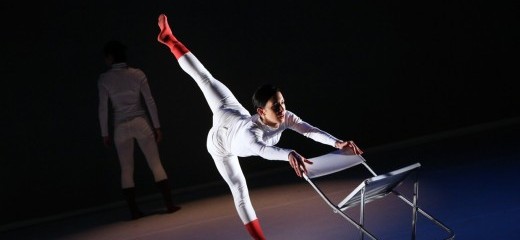
Belonging at Home
by Kalila Kingsford Smith
What is a home? Simply: where one lives. More broadly: a place where one feels safe, comfortable, rooted within community and family. But what happens to your concept of home when war and disaster threaten your safety? How do you build a home within a place that does not share your culture or background? Can you truly feel “at home” in a community that senses your difference?
Kun-Yang Lin/Dancers’ Home/S. 9th St. tries tackling these questions from the viewpoint of the immigrant, while addressing Lin's experience settling in Philadelphia’s S. 9th St. corridor. Lin’s choreography reflects the effects of cultural displacement through the bodies and the voices of his dancers, many of whom have migration stories of their own.
Six chairs in the upstage corner form what appears to be the shape of a boat: one in front, four in the middle, and one in back. Dancers sit in the bow and stern, and the remaining four stand in the middle facing each other. They gesture with their arms—pointing, stretching, shaking—one forms a corner with her two hands as though building a roof over her head. The dancer at the bow scoots her chair forward, and the dancers behind her follow—they slowly inch their way across the stage. Are they trudging through water? My mind can’t help but wander to the horrifying images of child refugees drowning on the way to asylum.
The dancers sit in chairs lined against the back wall. They look left and right, fling their hands forward and up, rest their elbows on their knees, grip a steering wheel. Their gestures build with increased speed and tension. Lin appears as a silhouette downstage. Pacing across the front of the space, he speaks into a microphone, “Sit up. Look at me. Look front. 1 2 3 4 5. Stop. Stop moving. Sit front. Look at me.…” The dancers don’t seem to hear him or understand, and they continue dancing in their chairs, unresponsive to the increasing panic and volume in his voice. I make note of his accent, reminded that this is his story.
“Number 207. What is your flight number? What is your final destination? Why are you coming to the U.S.? Why do you identify as an artist?” Each dancer is “called up,” and made to answer a deluge of immigration questions. Moving fluidly, they travel directly downstage, rolling through their bodies and jumping across the space. They shout answers to these questions “44. Philadelphia. Uh, I don’t know. Because I create….”
Liu Mo sits in a chair facing forward, expressionless. Three dancers approach him and push his shoulders, his arms, his legs. Each time, Mo resists, swiping their hands away from him. Their manipulations increase in speed, and still Mo remains expressionless, tossing their hands away, refusing to react. Meanwhile, Helen Hale and Evalina Carbonell circle around behind this group, laughing loudly and pointing at the interaction. I see a boy, bullied by his peers, unaccepted due to his difference, and refusing to give in to this tug of war.
“Parades of children… ice cream truck… grapefruit….” As Carbonell vocalizes what seems like a random set of phrases, the dancers roll their bodies and sweep their legs up around their chairs. They are fluid, yet contained, able to stop their motion with precision. Watching the exchange between her voice and the dancers’ movements, I am reminded that dance works more like poetry than like news. It moves within an abstract world, reflecting the internalization of an idea rather than a direct account. While words may suggest or add to an interpretation, the dancers’ movements express in ways that transcend translation.
I can’t help but wonder how much of the work’s impact came from Lin’s choreography. His representation of cultural displacement is potent and powerful; however many of my own interpretations were heightened by the current social debate and fear regarding refugees and migration from the Middle East. While Lin’s work participates in this discourse through his depictions of passage and cultural transition, I believe his intentions were to also symbolize his established sense of belonging as an artist and as a contributor to the character of Philadelphia. The evening finished with a recording of a community member saying, “Despite our differences we can still work together as a community.”
For another thINKing DANCE reflection on immigration, please see Carolyn Merritt's Human Movement here.
By Kalila Kingsford Smith
November 28, 2015





